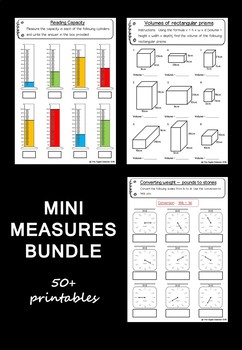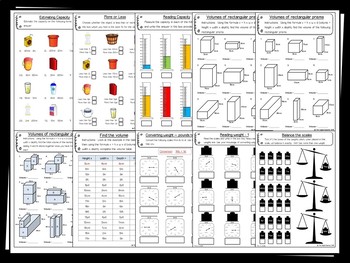Capacity, Volume and Weight – 50+ worksheets
Digital Stationer
256 Followers
Grade Levels
3rd - 5th, Homeschool
Subjects
Resource Type
Standards
CCSS3.MD.A.2
CCSS4.MD.A.1
CCSS4.MD.A.2
CCSS5.MD.A.1
CCSS5.MD.C.3a
Formats Included
- PDF
Pages
50+
Digital Stationer
256 Followers
What educators are saying
I used this as a review for the end of the year. I felt my students needed more practice and this aligned with my curriculum.
My students aged between 35 and 55 work in a factory employing adults with a wide range of learning disabilities. My role is to develop their literacy, numeracy and other workplace skills. These materials were readily adaptable and useful.
Description
Included in this pack:
Capacity/Volume Conversion Chart
Estimating capacity x 2
Comparing capacity
More or less
Reading capacity (Cylinders) x 2
Recording capacity (Cylinders) x 2
Create your own capacity (Cylinders)
Challenge a friend (Cylinders)
Reading capacity (Beaker) x 2
Recording capacity (Beaker) x 4
Create your own capacity (Beaker)
Challenge a friend (Beaker)
Volume/Capacity Conversion Chart
Counting the cubes x 5
Volumes of rectangular prisms x 3
Volumes of rectangular prisms (two prisms combined)
Find the volume table
Find the height, width or depth table
Weight conversion chart
Heavy vs Light - real life
Estimating real life weight
More or less - real life
Converting weight - milligrams to grams
Converting weight - grams to kilograms
Converting weight - kilograms to tonnes
Converting weight - ounces to pounds
Converting weight - pounds to stones
Reading weight x 6
Recording weight - milligrams
Recording weight - grams
Recording weight - kilograms
Recording weight - ounces
Recording weight - pounds
Recording weight - stones
Balance the scales x 2
Our other Measurement MINI Bundles are available here:
Area and Perimeter
Area, Perimeter & Length
Capacity and Volume
We also have Measurement MINI Bundles available here:
Capacity and Volume
Capacity, Volume & Weight
Or take a look at our larger Measurement MEGA Bundle which contains all the individual Measurement Packs, click the link:
Measurement MEGA Bundle
PDF format (please set print option to fit).
Your feedback is really important to us. We provide quality products at affordable prices and really would appreciate your feedback. With that in mind, please be kind enough to spare a minute or two to leave feedback on this product as it will help us improve our service to you the customer.
Thanks,
The Digital Stationer
Capacity/Volume Conversion Chart
Estimating capacity x 2
Comparing capacity
More or less
Reading capacity (Cylinders) x 2
Recording capacity (Cylinders) x 2
Create your own capacity (Cylinders)
Challenge a friend (Cylinders)
Reading capacity (Beaker) x 2
Recording capacity (Beaker) x 4
Create your own capacity (Beaker)
Challenge a friend (Beaker)
Volume/Capacity Conversion Chart
Counting the cubes x 5
Volumes of rectangular prisms x 3
Volumes of rectangular prisms (two prisms combined)
Find the volume table
Find the height, width or depth table
Weight conversion chart
Heavy vs Light - real life
Estimating real life weight
More or less - real life
Converting weight - milligrams to grams
Converting weight - grams to kilograms
Converting weight - kilograms to tonnes
Converting weight - ounces to pounds
Converting weight - pounds to stones
Reading weight x 6
Recording weight - milligrams
Recording weight - grams
Recording weight - kilograms
Recording weight - ounces
Recording weight - pounds
Recording weight - stones
Balance the scales x 2
Our other Measurement MINI Bundles are available here:
Area and Perimeter
Area, Perimeter & Length
Capacity and Volume
We also have Measurement MINI Bundles available here:
Capacity and Volume
Capacity, Volume & Weight
Or take a look at our larger Measurement MEGA Bundle which contains all the individual Measurement Packs, click the link:
Measurement MEGA Bundle
PDF format (please set print option to fit).
Your feedback is really important to us. We provide quality products at affordable prices and really would appreciate your feedback. With that in mind, please be kind enough to spare a minute or two to leave feedback on this product as it will help us improve our service to you the customer.
Thanks,
The Digital Stationer
Total Pages
50+
Answer Key
N/A
Teaching Duration
N/A
Report this resource to TPT
Reported resources will be reviewed by our team. Report this resource to let us know if this resource violates TPT’s content guidelines.
Standards
to see state-specific standards (only available in the US).
CCSS3.MD.A.2
Measure and estimate liquid volumes and masses of objects using standard units of grams (g), kilograms (kg), and liters (l). Add, subtract, multiply, or divide to solve one-step word problems involving masses or volumes that are given in the same units, e.g., by using drawings (such as a beaker with a measurement scale) to represent the problem.
CCSS4.MD.A.1
Know relative sizes of measurement units within one system of units including km, m, cm; kg, g; lb, oz.; l, ml; hr, min, sec. Within a single system of measurement, express measurements in a larger unit in terms of a smaller unit. Record measurement equivalents in a two-column table. For example, know that 1 ft is 12 times as long as 1 in. Express the length of a 4 ft snake as 48 in. Generate a conversion table for feet and inches listing the number pairs (1, 12), (2, 24), (3, 36),...
CCSS4.MD.A.2
Use the four operations to solve word problems involving distances, intervals of time, liquid volumes, masses of objects, and money, including problems involving simple fractions or decimals, and problems that require expressing measurements given in a larger unit in terms of a smaller unit. Represent measurement quantities using diagrams such as number line diagrams that feature a measurement scale.
CCSS5.MD.A.1
Convert among different-sized standard measurement units within a given measurement system (e.g., convert 5 cm to 0.05 m), and use these conversions in solving multi-step, real world problems.
CCSS5.MD.C.3a
A cube with side length 1 unit, called a “unit cube,” is said to have “one cubic unit” of volume, and can be used to measure volume.




